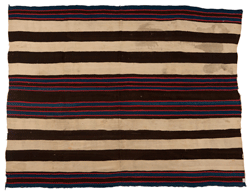|
Navajo First Phase Chief’s Blankets were made between about 1820 and 1850. Today, only about 50 still exist, which is one reason why one was appraised on the Antiques Roadshow in 2002 for $350,000 to $500,000. The blanket pictured here was created in about the 1840s, and it has its own incredible story and a link to that Roadshow blanket.
It was correctly identified by Ted Carlton of Utah and Sherron Lawson of Roswell, Ga.
A man known as “L.T.” happened to see that episode of the Antiques Roadshow and realized he had an Indian blanket just like it with horizontal lines. He contacted John Moran Auctioneers in Altadena, Calif., and they confirmed that it was a First Phase Chief’s Blanket. At first, it was valued at $50,000 and then upon closer examination, the value was put at $100,000 to $200,000. The blanket was ultimately sold at John Moran for an astonishing $1.5 million, before buyer’s premium.
|

L.T.’s First Phase Chief’s Blanket here sold for $1.5 million.
(Photo, courtesy of John Moran Auctioneers, www.johnmoran.com.)
|
This story had a second silver lining—L.T. had previously lost a leg in a car accident, and until the sales of the blanket, he and his wife had been squeaking by on disability payments.
Navajo First Phase Chief’s Blankets were outrageously expensive even when they were first made in the 1800s. Usually, they sold for between $100 and $200, which in the mid-1800s could be a year’s salary for a person who was doing well or four or more years’ salaries for the regular folk.
Navajo blankets could be worn during the day when it was cold and sat on or slept on at night. Chief’s Blankets were usually worn for ceremonial purposes only.
First Phase Blankets are distinguished by their horizontal lines. Second Phase Blankets always feature 12 rectangles, and Third Phase have diamonds and half diamonds; both phases also have horizontal lines of differing lengths1. Second and Third Phase designs continued until about 1880. After that, cheap knock-offs of these blankets appeared, and prices dropped like dibé bichaa' (sheep poop) hitting the trail.
Having lived on the Navajo Reservation for two years in the late 1970s, I was able to witness authentic rugs/blankets being woven from time to time. Large blankets required a large (and to my untrained eye, complicated) loom that was set up by hand with nearly a hundred warp strings. But first, a Navajo woman raised her own sheep to shear. Then, the wool was cleaned and dyed with natural colors made from plants she gathered. The wool was straightened and untangled by carding it by hand before spinning.
I never saw a spinning wheel on the Reservation. Navajo women spun their wool into thread by hand using a dowel with a wooden round near the bottom to hold the yarn. They stretched the wool string in and out around the spinning dowel to make it tighter. The tighter the thread, the more threads needed to make a blanket, which made it more valuable.
When all was prepared, a wooden shuttle was used to pass the thread back and forth through the warp. A wooden comb was then used to beat the yarn down. All this was done as she sat on the ground or on the floor in a hoghan, usually in traditional dress—a solid-colored skirt, a velvet shirt and a squash blossom necklace.
The best rugs are symmetrical. They can be folded in half, and the design matches itself. There was always a flaw left in one corner of the rug. This was so the spirit that was woven into the rug could get out when the rug was done.
-----------------------------------------
1 PBS.org, Dennis Gaffney, “Navajo Chief's Blankets: Three Phases,” posted Feb. 16, 2007.
|